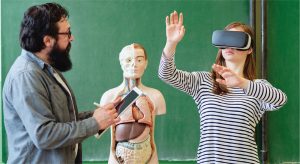9 Steps for Adopting Emerging Technologies
Technology – By Nicole Wang, Bill Magagna and Dr. Kyle Peck
Define the problem you want to solve. Emerging technology is not a panacea.
Emerging technologies (virtual reality, augmented reality and artificial intelligence) are likely to influence every industry within the next decade. Teaching and training are ripe for transformation, as technologies offer the ability to enhance authenticity and personalization. Medical students can practice surgical procedures through virtual reality (VR) goggles. Aircraft engineers can learn to fix engines on day one of training through an augmented reality (AR) and college students can graduate within three years through adaptive learning system powered by artificial intelligence (AI).
As instruction and curriculum development using these tools emerge, there is currently no “go to” source for advice on implementing best practices in adopting these technologies. Through our continuing partnership between LTEN and Penn State University, we conducted a series of case studies to better understand how pioneers in different sectors have adopted these technologies in their teaching and learning. Based on their advice, we offer nine basic steps to help our community members who are considering adopting a new technology.
Here are the recommended steps:
Step 1: Define the Problem
To start with, define the problem you want to solve. Emerging technology is not a panacea. It is crucial to define the problem before selecting any technology. For instance, if your problem is “how to help my staff remember the active ingredients in a series of new pharmaceuticals” then AR or VR might not be the best solution. However, if the problem is, “How to create a stronger sense of empathy among my new hires to the patients in a more efficient way,” then VR might be able to help.
Step 2: Select the Technology
Once the problem is defined, then it’s time to select which technology can help solve the problem. AR has been used widely as a scaffold to help train step-by-step procedures. AI has been used in the development of personalized or adaptive learning systems that can efficiently work for learners with diverse levels of background knowledge. VR has been used to provide for immersive experiential learning experiences that can even help “train the intangibles,” such as emotion and empathy.
Step 3: Gain Support from Leadership
After you have selected the technology, it is time to gain support from the leadership. Find a way to involve them from the early stage, create a sense of urgency and have them be part of the technology adoption process. It is crucial to have leadership realize the organization will benefit from the technology adoption, and the technology is the most effective way to solve the problem.
Step 4: Create a Talent Pool
In general, the adoption will involve a team of experts consisting of an instructional designer, a technologist, a content expert and a project coordinator. Depending on the skills and backgrounds of each person, team members may wear multiple hats, depending on the situation. However, we highly suggest avoiding assignments that cause a team member to learn one of the areas of expertise on the spot. The learning curve will consume a lot of time and energy and might even postpone the pilot launch of the project.
It is crucial to have leadership realize the organization will benefit from the technology adoption, and the technology is the most effective way to solve the problem.
Step 5: Set Up a Pilot Program
Next, set up a pilot program in your organization. Adoption on a smaller scale is easier to monitor to determine the degree to which the technology-enhanced solution is effective, and to estimate cost effectiveness. Not all staff members who are chosen to be in the pilot program should be early adopters who are happy to change.
Step 6: Budget
Be realistic – really – about the budget. Consider time and resources. How much time is each of the team members going to dedicate? What other resources will be required? Do you need to modify a physical space for implementation? Do you need to install Internet or modify the network in the physical space where the implementation will occur? Do you need to set props in the physical space? Do you need to hire people with new skills for the development? What is the equipment going to cost? Things like this need to be determined in fine detail when setting up the budget.
Step 7: Development
There are several things you need to think through. Choose one topic to start with. Once you have selected a topic, it is time to decide if you want to develop everything from scratch or purchase components “off-the-shelf.” Depending on the partner you are going to work with, you might be able to customize an acquired program. If you decide to develop everything from scratch for VR, then you also need to choose the video creation equipment. If your budgetary constraints are a factor, you may want to consider low-end options (like a Go-Pro camera) as you develop prototypes.
 In addition to the development tools, you will need to select equipment trainees will use. If you are adopting AR or VR, once you have chosen the software, it is time to select a compatible hardware. Get the highest quality equipment your budget will allow, so that learners will have the best possible experience. If you are considering developing adaptive learning from scratch, you need to choose between algorithms for supervised or unsupervised learning. You will also need to consider how much data you have on learners and what they know, and how much more data you plan on collecting, which may influence whether you will incorporate cloud-based servers and associated HIPAA compliance. Also, do not expect the program to be perfect in the beginning.
In addition to the development tools, you will need to select equipment trainees will use. If you are adopting AR or VR, once you have chosen the software, it is time to select a compatible hardware. Get the highest quality equipment your budget will allow, so that learners will have the best possible experience. If you are considering developing adaptive learning from scratch, you need to choose between algorithms for supervised or unsupervised learning. You will also need to consider how much data you have on learners and what they know, and how much more data you plan on collecting, which may influence whether you will incorporate cloud-based servers and associated HIPAA compliance. Also, do not expect the program to be perfect in the beginning.
Step 8: Implementation and Evaluation
Make sure to establish evaluation metrics prior to implementation and monitor the progress throughout the implementation. Be as objective as possible during the evaluation process. Remember that the goal is to solve the problem — the technology is just a means to an end. Make sure the technologist will be onsite during implementation so that he/she can troubleshoot.
Remember that the goal is to solve the problem — the technology is just a means to an end.
Step 9: Share and Expand
Finally, share the results of the pilot program and expand to more programs if the results indicate effectiveness. There will be potential unexpected issues during expansion, and it is important to stay positive. Plan on cycles of implementation, testing and revision.
If you have questions, are willing to participate in a needs assessment survey, or would like to learn more about our ongoing research project, please contact us. The goal for our research project is to help the members of our LTEN community.
Share Your Thoughts on the Survey!
Nicole Wang is a Ph.D. candidate at the Pennsylvania State University. Email Nicole at nicolewang12@gmail.com. William Magagna is vice president, Siemens Healthcare, and a member of the LTEN Board of Directors. Email Bill at william.magagna@siemens.com. Dr. Kyle Peck is Professor Emeritus at Pennsylvania State University.












